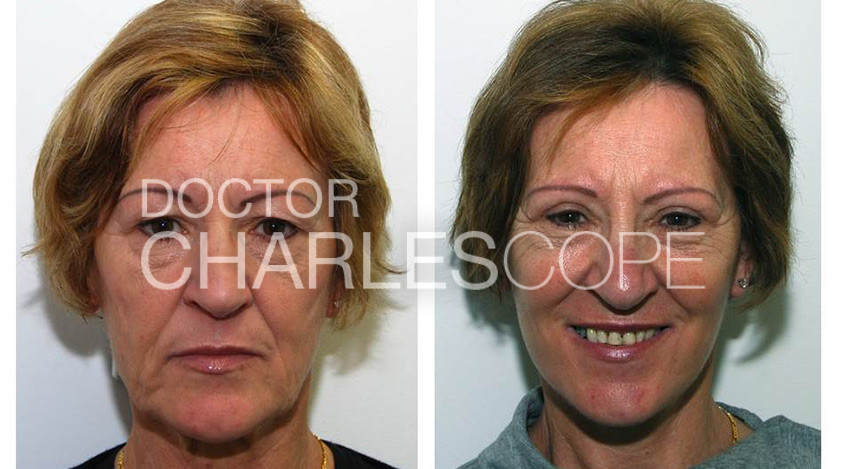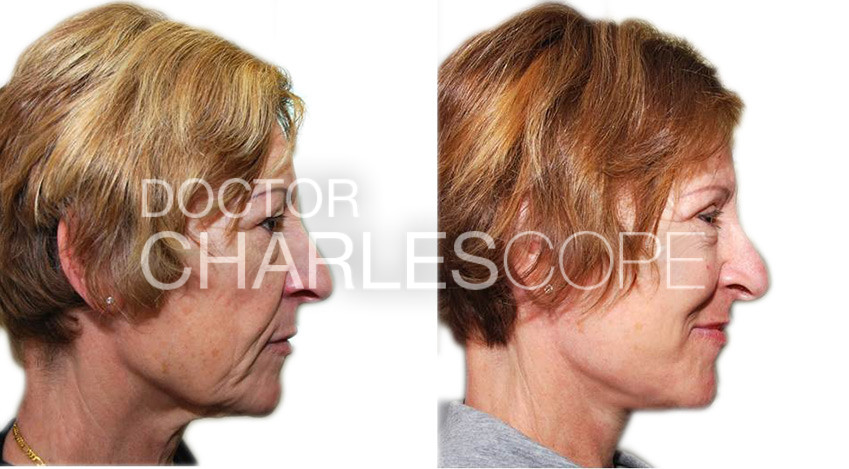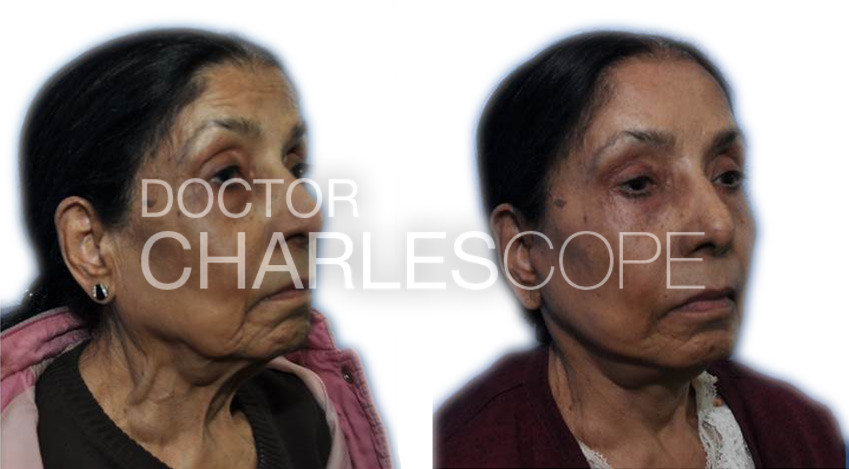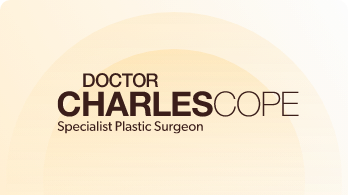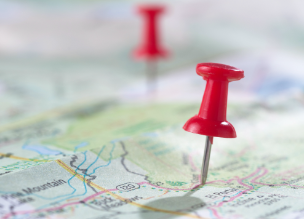Deep plane facelift (rhytidectomy) surgery aims to lift the facial skin along with the structures beneath. It helps to address concerns about lines on the cheeks, over the jawline, and in the neck. By targeting the skin, fat, and muscles, it can adjust the shape and contour of the face and neck.
Here in Sydney, our Specialist Plastic Surgeon, Dr Charles Cope, often combines a deep plane facelift (rhytidectomy) with other procedures. This includes surgeries such as blepharoplasty (eyelid surgery to remove skin or fat) or a brow lift (browplasty), which we can combine to address concerns in the upper part of the face. It may also include facial fat transfer, or perioral dermabrasion, similar to laser resurfacing, to improve lines around the mouth and on the lips.
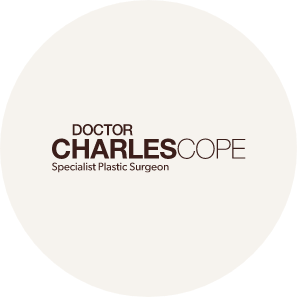
If you are not ready for surgery, there are also a number of options, such as SkinTyte or Ultraformer III. These skin-tightening treatments have much less downtime than surgery*. However, the effects are not as dramatic or as long-lasting as a deep plane facelift (rhytidectomy facelift).
Many patients who have deep plane face lift (rhytidectomy) surgery in Sydney also have other treatments to improve the skin quality. Treatments such as Halo, Profractional laser resurfacing, or Broadband Light (BBL) can help treat concerns with skin texture and appearance.* For more details about this type of facelift procedure, contact our clinic for consultation with Dr Cope.
*Note results vary from patient to patient
Your consultations with Dr Cope
Before you get any type of surgery, you will need to consult with a skilled surgeon such as Dr Cope. This private meeting will help you build your knowledge about the procedure and how it may serve your needs. Keep in mind that deep plane facelift (rhytidectomy) surgery is not for everyone. As a result, your first meeting with Dr Cope will involve speaking about your health and desired results. You will need to explain your goals and why you feel that surgery is a good option for you, as well as any health issues you may have. Only once we have these details may we proceed with planning your deep plane facelift (rhytidectomy).
Following your first meeting, you will also need to have a second discussion with Dr Cope. Two consultations are required before any cosmetic surgery in order to finalise the details of the procedure. We will ensure that you have a good grasp of what the procedure entails, as well as the recovery process. You will also need to have knowledge of the risks involved. You will then be able to schedule and begin preparing for your surgery.
Please note that in order to have a consultation for surgery, you will need a valid GP referral.
Surgery candidate
Candidates for deep plane facelift (rhytidectomy) surgery can be men or women. It is important, however, that patients fit the criteria for a good candidate. We will discuss this in your consultation. Patients who are to undergo this procedure typically have skin laxity or wrinkles in the midface, lower face or neck. These concerns are generally moderate or severe, which means the patient cannot achieve their desired look without surgery. This is more prevalent in people over the age of 40.
Generally, a good candidate for rhytidectomy face lift surgery include those who:
- Are healthy, and are able to maintain a stable weight
- Do not have serious health issues that could impact the procedure
- Are prepared to take time off work and follow all aftercare instructions
- Are aware of the risks involved in surgery
- Have achievable goals for their surgical outcomes
During the consulting process, Dr Cope will review your medical history and ask you about your health. This will help clarify whether deep plane facelift (rhytidectomy) is a suitable choice for you.
Cost of a deep plane facelift (rhytidectomy) in Sydney
Face lift (rhytidectomy) costs may vary, as each patient will receive a tailored surgical plan. As a result, the costs of this surgery generally depend on several factors. These include the following:
The anaesthetist’s fees
This can be charged by the hour or procedure.
Surgeon’s fees
The surgeon’s fee will depend on the level of skill and experience they have. Many patients find that care from a more qualified surgeon is worth the higher cost.
The type of surgery
Your surgeon may perform a different type of facelift (rhytidectomy facelift) depending on your goals.
The length of hospital stay
Depending on their condition, most patients need to stay overnight and go home the next day. For a face lift procedure such as a deep plane facelift, you will need an overnight stay in the hospital.
Other costs
You should also be aware of other costs that come along with surgery. This may include medical tests, and medications. It may also include materials used during the procedure.
Patients may wonder if Medicare may help to reduce the cost of their facelift procedure (rhytidectomy). You should know that Medicare only provides aid for surgeries that the patient needs for health reasons. Since this procedure is done for cosmetic reasons only, neither Medicare nor private health insurance will cover the costs. Make sure to clarify this with your insurance provider before having the procedure.
To know more about the total costs of the procedure, Dr Charles Cope will provide you with a detailed breakdown during your initial meeting.
Preparing and Post Deep Plane Face Lift (Rhytidectomy) Surgery
Preparing for face lift (rhytidectomy) surgery
Dr Cope stresses that patients should quit smoking at least six weeks before the surgery. Smoking slows blood flow to the skin and significantly increases the chance of infections and healing problems after the surgery. You will also need to stop taking anti-inflammatory medicine before surgery. This includes aspirin, some vitamins, and herbal remedies, including fish oil. If you are unsure about which health remedies you are allowed to take, consult Dr Cope.
Getting your deep plane facelift (rhytidectomy) at a Sydney hospital
Deep plane face lift or rhytidectomy occurs under general anaesthesia. The surgery takes about three hours and requires an overnight stay in the hospital.
There are many different ways to complete the procedure. Generally, Dr Cope uses a technique that involves altering the deeper muscle layer of the face as well as the skin (deep plane facelift).
Post-surgery care
After the surgery at one of our Sydney hospitals, it is important to rest and minimise your activities. Do not perform lifting or heavy duties for 10-14 days. There is always some bruising and swelling after the surgery. However, wearing an elastic support garment and resting as much as possible after the surgery can help reduce this. After a few days, you can wear makeup.
During the first 7-10 days after surgery, you need to rest and take things slowly at home. When you go home, you need to wear a support garment at all times except when showering. The wounds need to be cleaned, and antiseptic ointment should be applied a few times a day. You need to come into the office a few times in the first 10 days for Manual Lymphatic Drainage and LED light treatments to help the healing process.
These post-op treatments are designed to help the healing process and can have a positive effect on swelling. However, the effects may vary. Most patients also have some numbness and tightness, which should slowly fade over a few weeks. The scars from facelift (rhytidectomy) surgery should fade with time, although occasionally they require further treatment.
*Most patients may drive again and return to work and sport within two to three weeks after surgery.
*Note results vary from patient to patient
By tightening the muscle layer beneath the skin, the procedure helps to lift the facial structures in their new position. Altering the muscles also helps to reduce the tension on the skin closure, which reduces the chance of problems with scarring. Please note, however, that scars are expected after the procedure.
Dr Cope will place your incisions mainly in the hairline. Some incisions will also be in the natural crease in front of the ear, going under and behind the earlobe and back into the scalp. Generally, there is also a small incision under the chin. The surgeon lifts the skin off the muscle layer and tightens the muscle layer. He then removes any excess fat with liposuction. Following this, the loose excess skin is removed, and the wound is closed.
Dr Charles Cope will discuss options with you and be able to provide you with a customised plan that fits with your goals.
Risks and complications
It is possible to have complications during and after surgery. Although most patients don’t experience any severe adverse effects, there is always a risk. Therefore, being aware of the risks is important, as it allows you to make balanced and well thought-out decisions. You can expect certain side effects from the procedure, such as temporary swelling and bruising. These are considered normal.
However, the potential more severe risks of deep plain facelift (rhytidectomy) surgery include:
- Excessive bleeding
- Infection, or wound healing problems
- Ongoing pain and swelling
- Uneven or unwanted results
- Poor scarring
- Damage to facial structures
- Numbness or loss of sensation
- The need for further surgery
Why choose Dr Cope for rhytidectomy facelift surgery
Your choice of facelift surgeon is integral to the surgery planning process. A good surgeon will be properly qualified and able to help you make decisions that suit your needs, both cosmetic and health-related. Consult with Dr Charles Cope in Sydney to learn more about deep plane facelift plastic surgery (rhytidectomy). We are available at our clinics in Mosman, Wahroonga, and Gosford.
Frequently Asked Questions
This depends on the signs of ageing you are concerned about and your goals. For many patients, the right time is when skin laxity and wrinkles are bothering them. Most face lift rhytidectomy patients are between 45 and 65 years old, although ages vary from people in their 30s to 70s.
With ageing, the skin, fat, and muscles of the cheeks and neck become loose. This can result in lines and laxity between the cheeks and lips, over the jawline, and in the neck. Face lift rhytidectomy surgery aims to improve the visible signs of ageing. It does this by removing excess skin and fat and tightening the underlying muscles of the face and neck.
The final result will vary between patients, due to your own facial anatomy, surgical plan, and the skill and experience of your surgeon. You can discuss the possible outcomes of your deep plane facelift (rhytidectomy) with Dr Charles Cope.
The procedure aims to reduce visible signs of ageing in a way that is long-lasting. However, you continue to age and develop more skin laxity and wrinkles with time. Many people have a second facelift 10 years later, and occasionally a third time, depending on your age when you first have surgery.
Many people have other procedures performed at the same time. The most common are facial fat transfer, upper or lower eyelid surgery (blepharoplasty), and browlift (browplasty). There are also non-surgical treatment options to target facial ageing.
Skin-tightening devices such as SkinTyte and Ultraformer III help target concerns about facial ageing. These treatments heat the skin to produce an increase in natural collagen. This collagen continues to increase in the months after your treatment, with little downtime. However, the choice between surgical or non-surgical treatment will depend on the patient and their own needs.
While people have the procedure at any time of the year, you will need to consider that wearing a support garment is part of recovery. Wearing this garment tends to be more comfortable in the cooler winter months. Some patients also find it easier to disguise the garment and bruising with scarves during winter. However, people often organise the surgery when they can best take time off work. This might be just before Christmas or in January if work is quiet then.
We perform the surgery in an accredited hospital. All patients stay overnight to recover from the anaesthetic, as the operation takes two to three hours.
Surgeons place the incisions mainly within the hairline, starting in the natural crease in front of the ear. The incision then goes under and behind the earlobe and back into the scalp, and usually, there is also a small incision under the chin.
Although some people can return to work in 10 days, for most people, it is two to three weeks until they are ready to return to work, sports and full activities.*
*Note results may vary from person to person


